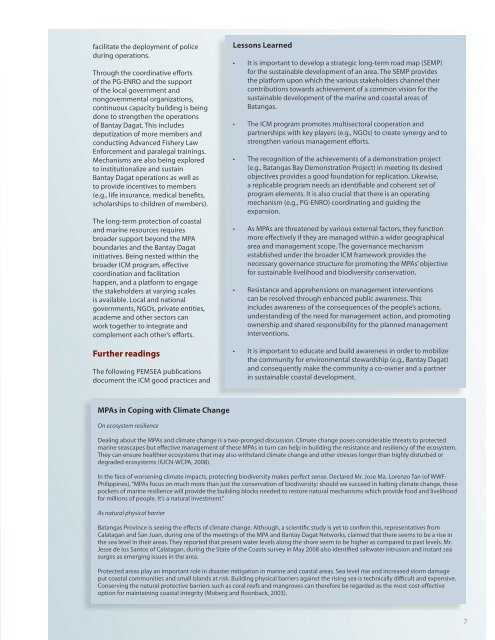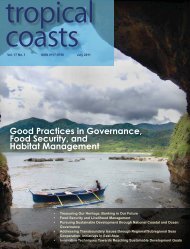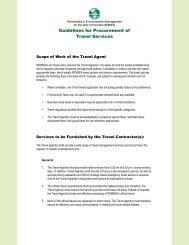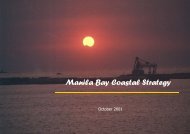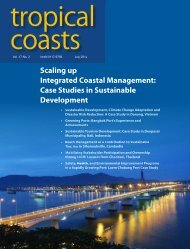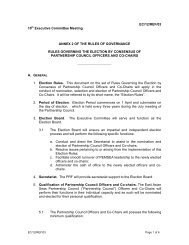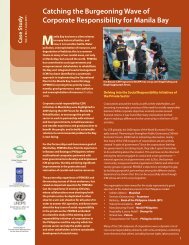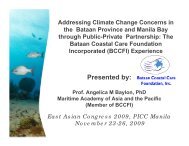You also want an ePaper? Increase the reach of your titles
YUMPU automatically turns print PDFs into web optimized ePapers that Google loves.
facilitate the deployment of policeduring operations.Through the coordinative effortsof the PG-ENRO and the supportof the local government andnongovernmental <strong>org</strong>anizations,continuous capacity building is beingdone to strengthen the operationsof Bantay Dagat. This includesdeputization of more members andconducting Advanced Fishery LawEnforcement and paralegal trainings.Mechanisms are also being exploredto institutionalize and sustainBantay Dagat operations as well asto provide incentives to members(e.g., life insurance, medical benefits,scholarships to children of members).The long-term protection of coastaland marine resources requiresbroader support beyond the MPAboundaries and the Bantay Dagatinitiatives. Being nested within thebroader ICM program, effectivecoordination and facilitationhappen, and a platform to engagethe stakeholders at varying scalesis available. Local and nationalgovernments, NGOs, private entities,academe and other sectors canwork together to integrate andcomplement each other’s efforts.Lessons Learned• It is important to develop a strategic long-term road map (SEMP)for the sustainable development of an area. The SEMP providesthe platform upon which the various stakeholders channel theircontributions towards achievement of a common vision for thesustainable development of the marine and coastal areas ofBatangas.• The ICM program promotes multisectoral cooperation andpartnerships with key players (e.g., NGOs) to create synergy and tostrengthen various management efforts.• The recognition of the achievements of a demonstration project(e.g., Batangas Bay Demonstration Project) in meeting its desiredobjectives provides a good foundation for replication. Likewise,a replicable program needs an identifiable and coherent set ofprogram elements. It is also crucial that there is an operatingmechanism (e.g., PG-ENRO) coordinating and guiding theexpansion.• As MPAs are threatened by various external factors, they functionmore effectively if they are managed within a wider geographicalarea and management scope. The governance mechanismestablished under the broader ICM framework provides thenecessary governance structure for promoting the MPAs’ objectivefor sustainable livelihood and biodiversity conservation.• Resistance and apprehensions on management interventionscan be resolved through enhanced public awareness. Thisincludes awareness of the consequences of the people’s actions,understanding of the need for management action, and promotingownership and shared responsibility for the planned managementinterventions.Further readingsThe following <strong>PEMSEA</strong> publicationsdocument the ICM good practices and•It is important to educate and build awareness in order to mobilizethe community for environmental stewardship (e.g., Bantay Dagat)and consequently make the community a co-owner and a partnerin sustainable coastal development.MPAs in Coping with Climate ChangeOn ecosystem resilienceDealing about the MPAs and climate change is a two-pronged discussion. Climate change poses considerable threats to protectedmarine seascapes but effective management of these MPAs in turn can help in building the resistance and resiliency of the ecosystem.They can ensure healthier ecosystems that may also withstand climate change and other stresses longer than highly disturbed ordegraded ecosystems (IUCN-WCPA, 2008).In the face of worsening climate impacts, protecting biodiversity makes perfect sense. Declared Mr. Jose Ma. Lorenzo Tan (of WWF-Philippines), “MPAs focus on much more than just the conservation of biodiversity: should we succeed in halting climate change, thesepockets of marine resilience will provide the building blocks needed to restore natural mechanisms which provide food and livelihoodfor millions of people. It’s a natural investment.”As natural physical barrierBatangas Province is seeing the effects of climate change. Although, a scientific study is yet to confirm this, representatives fromCalatagan and San Juan, during one of the meetings of the MPA and Bantay Dagat Networks, claimed that there seems to be a rise inthe sea level in their areas. They reported that present water levels along the shore seem to be higher as compared to past levels. Mr.Jesse de los Santos of Calatagan, during the State of the Coasts survey in May 2008 also identified saltwater intrusion and instant seasurges as emerging issues in the area.Protected areas play an important role in disaster mitigation in marine and coastal areas. Sea level rise and increased storm damageput coastal communities and small islands at risk. Building physical barriers against the rising sea is technically difficult and expensive.Conserving the natural protective barriers such as coral reefs and mangroves can therefore be regarded as the most cost-effectiveoption for maintaining coastal integrity (Moberg and Roonback, 2003).7


